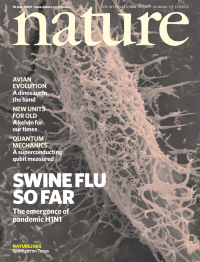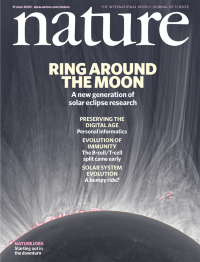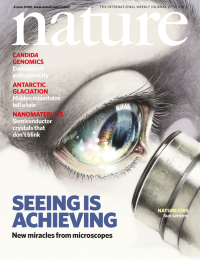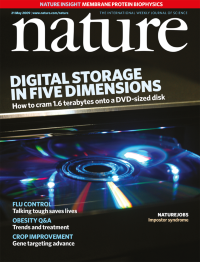Volume 459
-
No. 7250 25 June 2009
In Too close for comfort, Boyce Rensberger reflects on the changing relationship between science and the media, most notably the transition of the role of science reporter. Once cheerleaders for their field, they are now sceptical observers, more like their news-reporter colleagues. This is one of a series of pieces in this weeks issue commissioned in the run-up to the 6th World Conference on Science Journalism. Cover graphic: Jim Field.
-
No. 7249 18 June 2009
With the swine-origin H1N1 influenza outbreak now officially a global pandemic, Gabriele Neumann, Takeshi Noda and Yoshihiro Kawaoka take stock of our knowledge of the emergence of the H1N1 virus, and compare its antigenic and pathologic properties with those of previously circulating influenza strains. The cover image shows a scanning electron micrograph of H1N1 viruses (A/California/04/09) emerged from a virus-infected cell. Most of the virus particles seen covering the cell are filamentous rather than spherical. [Image: G Neumann et al.]
-
No. 7248 11 June 2009
On the cover, a composite of 25 images showing the east limb of the Sun during the total solar eclipse of 1 August 2008, observed from Mongolia. The latest methods of image processing were used to bring out spatial details, revealing the structure of the coronal magnetic field. As Jay Pasachoff explains in a Review, a new generation of eclipse studies is linking solar observations from satellites with ground-based observations. Credit: Miloslav Druckmüller (Brno University of Technology)/Martin Dietzel & Peter Aniol (ASTELCO Systems, GmbH)/Vojtech Ruin (Slovak Academy of Sciences).
-
No. 7247 4 June 2009
This weeks Nature looks through new windows into life being generated by microscopists in recent years, beginning on page 629 with a collection of News Features on microscopic marvels. [Cover graphic: David Parkins.]
-
No. 7246 28 May 2009
On this weeks cover, a transgenic marmoset (Callithrix jacchus) containing the self-inactivating lentiviral vector CAG-EGFP. A team from seven Japanese institutions has generated transgenic marmosets in which the integrated transgene is transmitted through the germline and expressed in the offspring. This new non-human primate model, amenable to gene manipulation with transgenic technologies, should be invaluable for biomedical research into disease mechanisms and for developing therapies in gene therapy and regenerative medicine.
-
No. 7245 21 May 2009
In the cause of cramming more and more data onto optical storage devices, materials scientists have sought to add extra dimensions to recording media, literally. Now Zijlstra et al. have developed a five-dimensional optical recording technique with the potential to increase storage capacities by several orders of magnitude — a theoretical 1.6 terabytes capacity for a DVD-sized disk. [Cover image: Peter Zijlstra & James W. M. Chon]
Insight
-
No. 7244 14 May 2009
qiRNAs are a novel class of small RNAs identified by Heng-Chi Lee et al. in the filamentous fungus Neurospora, where they may play a role in DNA repair as inhibitors of protein translation. The cover shows a rosette of maturing Neurospora asci with fluorescing binucleate ascospores, indicated by GFP-histone H1. [Cover photo by Namboori B. Raju, and modified by Heng-chi Lee and Allen Tsai.]
Insight
-
No. 7243 7 May 2009
The diminutive hominin Homo floresiensis, first described in Nature in 2004, lived on the island of Flores in Indonesia until about 14,000 years ago. The cover shows the partial skeleton of the type specimen, LB1, which preserves enough material to permit partial assembly of the foot, as reported this week by Jungers et al. [Cover illustration by Djuna Ivereigh/Arkenas; preparation by Luci Betti-Nash.]








